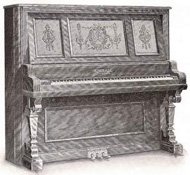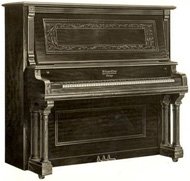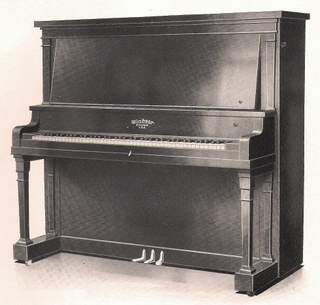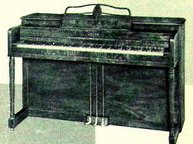简介:
现存的最早的立式钢琴是1739年弗罗伦斯的制作师多米尼戈.德尔.梅拉制作的。它以击弦古钢琴为基础,形状像一个以键盘为底边的竖放的大钢琴。为使形状对称,琴弦震动系统被装饰成三角形的琴壳,由此得名“金字塔钢琴”。德国的克里斯蒂安.恩斯特.弗雷德里奇同样也造了金字塔型的钢琴,它饰有花纹的琴壳设计被许多不同形状的钢琴采用,如里拉夫鲁格尔,因其形似里拉琴而得名。 18世纪末,心事的竖立型钢琴问世,形状如长颈鹿。它出自维也纳,极富装饰性的琴壳做成了大钢琴的模样,长长的曲线向上延伸,字啊乐器顶端形成一个涡旋。长颈鹿钢琴结合了四至七个踏板,音域范围惊人,包括土耳其近卫军的声音效果。 在英格兰,层出不穷的创新推动了立式钢琴的发展。1795年,威廉.施托达特将他的“立式大钢琴”推向市场,1798年,威廉.锁斯威尔在他伦敦的店里卖掉了一台测立的方钢琴。经这些做法激发了公众一定的幸福,但这些乐器庞大的高度,大大的限制了他的发展。 1800年现代立式钢琴的进化同时也在维也纳和费城展开。马赛尔斯.穆勒和约翰.埃克斯.豪金斯都制作出了琴弦在音板后一直延展到地面的立式钢琴。豪金斯的四英尺半高的钢琴似乎与它的音量相比有点不成比例,但它仍不失为做工精巧的作品,它包括一个铁质框架,一个装在垂直弦前面的托木连动装置。 1811年,罗布特.无纳姆取得了生产高度略低的“农舍”钢琴的专利,1814年在伦敦开始制造成功。与豪金斯的钢琴相似的是,它有一个顶杆连动装置,而沃纳母1826年又在此基础上加以改进,1842年,沃纳母的襻带—托木连动装置成为现代立式钢琴的基础。“农舍”钢琴的普及似乎发生在一夜之间,其他的制造商如布洛德伍德和克莱门第很快发现它商机无限,在法国它被广泛接受。世纪之交时,巴黎的建筑趋向于小型公寓化,空间的有限使得原本适合放大钢琴或方钢琴的屋子,现在却变成适合放这种新式的钢琴。普莱耶尔是一市场的领头羊,他以罗伯特.沃纳母“农舍”钢琴和让.亨利.帕普1828年的专利为基础,制作了“皮阿尼诺斯”。 让.亨利.帕普的专利是40英寸的有支撑的钢琴,首次应用了分层张弦结构,增加了琴弦长度并改进了钢琴音色。巴黎的建筑风格很快风靡德国、英国各大城市对占地面积较小的乐器需求也随之增加。1830年代,欧洲家用钢琴市场很快从方钢琴转向了立式钢琴。 到了19世纪60年代,一些美国制造商开始注意到了这种已趋完善的立式钢琴,并意识到他的最佳之处在于琴弦排列系统和全铁框架。但它的普及却又花了十年,斯坦威父子充分利用了这一点。城市生活的增加鼓励了像鲍德温,金伯和戴克尔兄弟等不断生产立式钢琴,以满足市场需求,而非仅出现于视觉上的需求。这种钢琴的低生产成本也决定了它在20世纪初,成为了大钢琴唯一变种。
The upright piano didn't become popular in American culture until the last quarter of the 19th Century. Prior to that time, the square grand piano was the preferred choice that dominated the American piano market.
Most of our vintage ephemera collection doesn't show upright pianos until the 1870's, although upright pianos were built on a limited scale all through the early and middle 19t Century. It is exceedingly rare that we see an upright piano dating prior to 1870 come through our restoration shop, indicating that the extant models of mid-19th Century upright pianos are very scarce today. |
.jpg)
Upright Piano, Circa 1870
.jpg)
Upright Piano, Circa 1880
.jpg)
Upright Piano, Circa 1890

Upright Piano, circa 1900

Upright Piano, Circa 1910

Upright Piano, Circa 1920
|
As the 20th Century approached, makers began shifting their production from the square grand piano to the upright piano, as the public's tastes were beginning to change and homes were becoming smaller and less suited for large square grand pianos. In the 1880s and 1890s, upright piano production increased substantially and by the last decade of the 19th Century the square grand piano that had dominated the market for the past century had all but vanished. Since this was the height of the Victorian era, manufacturers were building their upright pianos with exotic woods and lavish carvings, often producing incredibly ornate and lavish models to suit the décor of the era. The last decade of the 19th Century saw some of the finest craftsmanship and quality ever to be put into piano manufacturing.After the turn-of-the-century, tastes began to change and piano design began to become a bit more streamlined. The ostentatious styles of the late 19th Century gave way for more classic and simple design. The first decade of the 20th Century saw a calmer, less radical movement in interior design than the previous decades, and this change was immediately seen in the evolving styles offer by the major piano manufacturers.
From about 1900 - 1915, the Arts & Crafts Movement was a major force in American design. Although the Arts & Crafts design was very popular during the early 20th Century, piano makers were slow to adapt to the Mission/Arts & Crafts design. Furniture manufactures were quick to jump on the new trend of the Craftsman style, but piano makers were slow to recognize just how important the Arts & Crafts Movement really was. A handful of manufactures attempted to build pianos in the Craftsman/Mission style, but because the Movement was so short-lived, most of them didn't see the significance of the Arts & Crafts Movement until it was too late; the Arts & Crafts Movement was over before 1920. Sadly, very few manufacturers ever offered Craftsman style pianos, and as a result, original specimens are exceedingly raretoday.
The 1920's era was considered the "Golden Age" of piano building. By this time makers had streamlined operations and the piano had evolved into a perfect machine. The upright piano had evolved into a very simple basic design, becoming more utilitarian in appearance than ever before. With the exception of period furniture styles like Louis XV and French Provincial, most upright pianos were without ornamentation or frills. Instead, plain square pillars and streamlined moldings resulted in a very "modern" looking upright piano which was considered "uncluttered" and "beautifully simplistic". These simple looking upright pianos were generally of excellent quality, and were some of the finest pianos built in history.
The large and familiar upright piano was built up until about 1930 when the Great Depression hit. With the economy falling flat, manufacturers scrambled to find a way to save the industry. Within a couple of years, the piano industry introduced the "Spinet" piano, which was basically an upright piano of very small proportions - often standing no more than 36 inches high! The spinet piano took the public by storm, and all major manufacturers began producing them. Shortly after, the console piano was introduced, which was basically a slightly larger version of the spinet. Indeed, the spinet and console pianos saved the American piano industry, carrying it through the Great Depression and into the World War 2 years. Since then, most upright pianos are of the spinet or console type. Although many makers have consistently produced smaller studio uprights, the large upright piano of the early 19th Century was never built again.
UPRIGHT PLAYER PIANOS
More player pianos were built in America between 1900 and 1930 than any other single type of piano. A conventional player piano is operated via a perforated paper roll inserted above the keyboard, and large pumping pedals below the keyboard. While pumping these pedals, vacuum is created which pulls air through the holes in the paper roll, causing the piano note to play. By 1910, all major manufacturers had at least one line of player pianos. By 1920, player pianos dominated the market place. In the years before the phonograph and radio, the player piano was the only means of musical entertainment for the public at large. They were as common in the household then as our big screen television is today! Thousands of song titles were available for player piano rolls, and rolls were sold by the millions. By the time the Great Depression hit, the radio and phonograph offered a much more affordable means of entertainment, and the player piano seemed to vanish overnight.
 
Upright Piano, Circa 1930 Spinet Piano, Circa 1940
|
|
